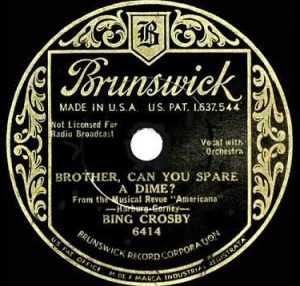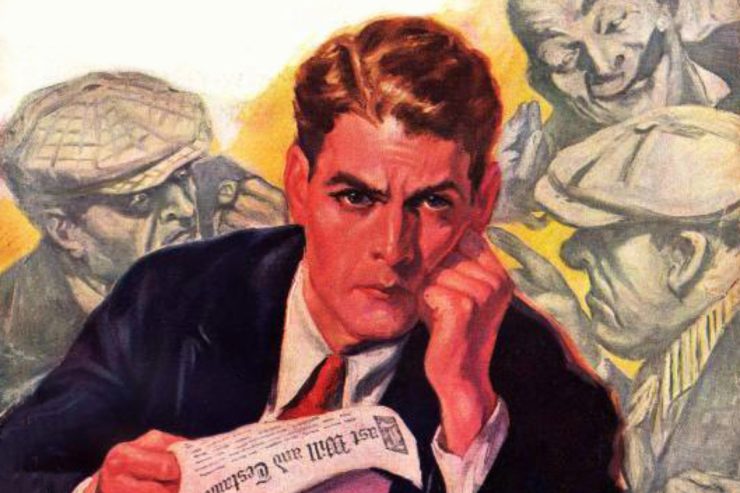Pulp magazines have influenced writers, artists, film directors, software developers, and countless others over the years. Our “Pulp History” articles focus on the rough-paper writers, editors, publishers, and artists who have inspired and continue to inspire the creators of the world’s popular culture.

Did you know that the “American Dream” began in 1931? The idea was older than that, of course, but the form in which we think of it today comes from a book entitled, The Epic of America by James Truslow Adams. He wrote the book during the depths of the Great Depression when people needed a reminder of what America was all about.
Adams admits that many Americans had grown mistrustful of the idea at that point. The American Dream tells us that all Americans have the potential to gain the “…fullest stature of which they are innately capable, and be recognized by others for what they are, regardless of the fortuitous circumstances of birth or position.” That may have sounded great on paper but when you looked out of your window in the early 1930s, what you saw on the streets was another thing entirely.
In 1932, the song “Brother Can You Spare a Dime” made its debut in the revival of a play called, Americana. The song was written by E.Y. “Yip” Harburg and composed by Jay Gorney. The haunting melody is based on a Russian-Jewish lullaby that Gorney’s mother had sung to him as a child. The song quickly gained notoriety and became the anthem of the Great Depression.
“They used to tell me I was building a dream, and so I followed the mob,
When there was earth to plow or guns to bear, I was always there right on the job.
They used to tell me I was building a dream, with peace and glory ahead,
Why should I be standing in line, just waiting for bread?”
It’s a powerful song that expresses the despair of the common man. Even today, nearly 100 years later, we can still feel the pain of those suffering Americans. In 1932, no one guessed that the New Deal was coming in just one more year. At that moment, people couldn’t see the end of the tragedy.
In The Epic of America, James Truslow Adams speaks of two educations — how to make a living and how to live. This is where the pulps come in.
During the 1930s news racks were filled with pulp magazines. The bright, eye-popping covers promised thrills untold. Every week, heroic G-men, brave detectives, secret agents, hearty adventurers, cowboys, pilots, and space heroes saved us from dark perils. People lived through those stories and depended upon them. The pulps gave readers a chance to leave their troubles behind and let their imaginations soar. They kept the American Dream alive.
When living in hard times people have a tendency to retreat. Under those conditions, there’s little room for creative daydreams and yet that’s when they’re needed most. In 1974, Jay Gorney said about his famous song, “I didn’t want a song to depress people. I wanted to write a song to make people think. It isn’t a hand-me-out song of ‘give me a dime, I’m starving, I’m bitter, it wasn’t that kind of sentimentality.”
In the song, a beggar talks back to the system that stole his job. He asks why the same men who built the nation, fought in the Great War, and did all their nation had asked of them, should now be abandoned and waiting in bread lines. Americans wanted to be proud again and pulp stories gave them a dream to hold to. They imagined themselves as the heroes and lived the adventures along with the characters. Whole families passed the magazines around and discussed them. Friends gathered to share their precious collections.
“First Fandom” developed among science fiction fans during the 1930s. These intrepid lads and lasses gathered and discussed and created. Their efforts produced amazing ‘zines and semi-pro magazines, like Science Fiction Digest. They created inspiring group projects such as the round-robin serial, “Cosmos.” Despite everything, they soared.
Saying that pulp stories helped people survive those hard times is not minimizing what they went through. It was awful, a disaster that we wouldn’t want ever to repeat. But people survived it and the common man once again was able to hold his head up high. There were many things that contributed to that happy conclusion and I think the pulps were one of them. Per aspera ad astra!
In 2022, PulpFest celebrates “50 years of Pulp Cons” with its theme, “Action For a Dime.” Join us at the celebration from August 4 – 7, 2022 at the DoubleTree at Hilton Hotel Pittsburgh – Cranberry in Mars, PA. We hope to see you there!
A professional journalist and illustrator with over thirty years of experience, Sara Light-Waller is an accomplished new-pulp fiction author/illustrator with two books out and more on the way. She is also the winner of the 2020 Cosmos Prize for her illustrated short story, “Battle at Neptune.” A huge pulp fan, Sara is especially fond of science fiction pulps. The extent of her pulp fandom can best be measured by the oversized rendition of Frank R. Paul’s August 1928 Amazing Stories cover that she painted on her garage. Sara is a member of the PulpFest organizing committee and a regular contributor to our website and The Pulpster.”
Originally performed by vaudeville singer Rex Weber as part of the 1932 musical Americana, “Brother, Can You Spare a Dime?” was covered by crooner Bing Crosby for Brunswick Records later the same year. We felt Paul Stahr’s cover art for the September 27, 1930 Argosy was the perfect representation of the despair felt by the common man during the Great Depression.






